TUTORIAL: VCF / VCA
2015.07.29In this series of tutorials, we will explore the parameters and history of the legendary ARP Odyssey in its current, reissued form. Here, we discuss the VCF and VCA.
Text: Ryota Hayashida (Iroha Studio)
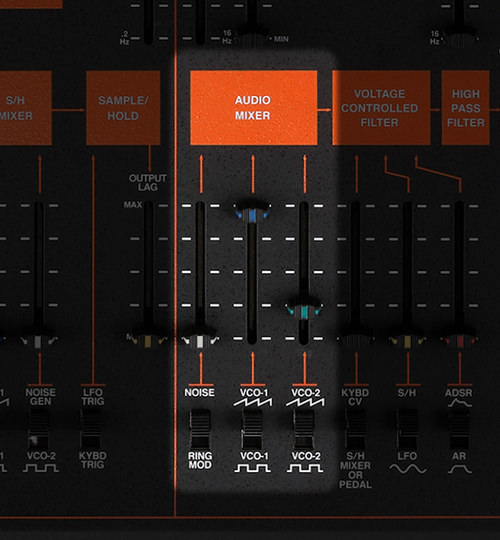
AUDIO MIXER
The two VCOs and the noise generator are combined and input to the internal audio mixer. The selection of the two waveforms (sawtooth wave and pulse wave) output from the VCO is also made here. The two VCOs are simultaneously sent to RING MOD (ring modulator), and you can select either these or noise and send it to the mixer.
RING MOD is a module that produces a pitch that is the sum and difference of the two VCOs, and is used to create metallic-sounding tones. If the two pitches were perfectly matched, there would in principle be no effect, but by deliberately making a slight difference between the pitches you can generate interesting overtones. By simultaneously using oscillator sync which forcibly matches these pitches, you can create even more fascinating overtone structures.
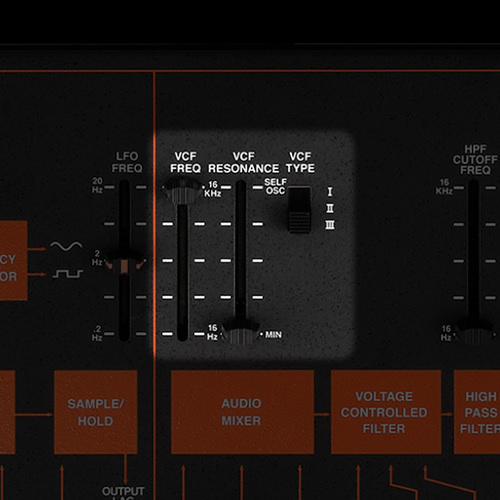
VCF
The audio signal from the AUDIO MIXER is sent to the VCF, or filter. (Here it’s a low-pass filter, which reduces the high-frequency overtones.) It is well-known that the original ARP Odyssey had three different types of low-pass filter depending on the date of production. The revived model lets you use the VCF TYPE switch to choose between these three versions.
Type I is the 4023 filter module used on the first model (Rev1); it’s a two-pole low-pass filter that’s -12 dB/octave; i.e., described by a curve that reduces the sound by 12 dB each time the frequency doubles. The -12 dB/octave response is fairly gentle, but it’s a unique filter with multiple feedback that’s different from a textbook circuit, allowing overtones to remain even when the filter is closed, and producing a crisp high-end. Even if you open the filter without raising the resonance, you get an ultra-high-frequency emphasis as if you were applying an exciter. Raising the resonance also makes it behave differently; the overall level increases, producing distortion. This distortion has a complexity and depth that can’t be obtained from other synths. To hear this for yourself, input pink noise and make the filter oscillate, and then lower the VCF FREQ. This filter also has an extensive low-range, and is just a great filter that played an important part in making the ARP Odyssey world-famous. Time after time, you’ll find yourself exclaiming “This is a great filter!” That’s because of its excellent audio response that lets the nuances of the original sound from the VCO shine through.
Type II was provided on the units of the middle period (Rev2). It’s a 24 dB/octave four-pole low-pass filter known as the 4035. Specifications were changed fairly soon from the type I to this filter. (It was a time when four-pole filters were mainstream.) It’s a type of filter known as a ladder filter, providing a crisp response while preserving the refined and warm feeling of Type I. However, the type II filter is relatively rare, and is found on only a few units. Although the change to a four-pole design strengthened its aggressive feeling, this filter still has plenty of fatness with a well-balanced and musical character.
Like type II, type III is also a -24 dB/octave four-pole filter, but since the circuit design is different the character is also quite different; it’s a low-pass filter with a more solid and sharp feeling. Although this filter is not going to get out of control even if you raise the resonance, it is capable of an aggressive amount of resonance.
All three types of filter were able to go into resonance if you raised the VCF RESONANCE slider to the top, so you should take advantage of this in your sound design. The position just slightly before oscillation is also interesting; in a nice touch, it’s even marked “SELF OSC.” If you want to use only the filter oscillation sound, you’ll need to lower all of the AUDIO MIXER sliders to cut the sound from the VCOs. The oscillation of the VCI is a pure sine wave which does not contain any overtones, and a popular way to use this is in the percussive “sweep” that’s often heard in techno. It’s very easy to create this; assign the VCF and VCA to ADSR, set the ADSR controls all to zero except for the decay, and set a fairly long time only for decay. Apply the VCF fairly strongly. The sound’s sense of pitch is determined by the strength of ADSR relative to the VCF and by the VCF FREQ position, so adjust these appropriately.
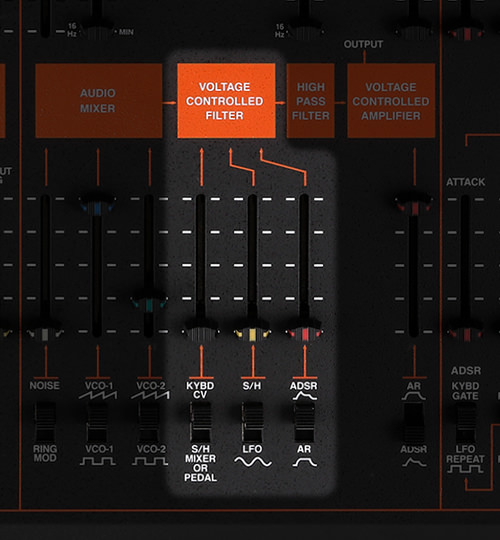
As I’ve mentioned, the variety of modulation that can be applied to the VCF here is unusual for a compact synthesizer. It’s one of the more profound differences between the Odyssey and others on the market today.
KYBD CV lets you use the CV signal produced by the keyboard to open or close the VCF FREQ of the filter. This is often used when you want the filter to open as the pitch rises, making the sound brighter. Conversely, for sounds such as synth bass, the high overtones can become more obtrusive as you play lower, but if you close down the filter, the higher octaves become muted in tone. That’s when this slider is useful. To obtain this effect, the filter has to be somewhat closed. Since you’re using the CV from the keyboard to open the filter, there won’t be any effect if the filter is already completely open. This is also useful when playing the instrument via external MIDI. In addition, a temperature compensation circuit is provided on the ARP Odyssey’s filter just as on the VCO.
From the time it first went on sale, the ARP Odyssey’s pitch stability was highly regarded. If you make the VCF oscillate and raise the KYBD CV, you can play the correct pitches from the keyboard.
S/H MIXER OR PEDAL is perhaps the ARP Odyssey’s greatest distinction. It allows the mixed signal to apply modulation to the VCO and VCF, producing sounds that are unattainable on other synthesizers. If a pedal is plugged into, its signal is used. If not, the sound output from the S/H MIXER will be the source. The VCOs combined at the S/H MIXER have not passed through the filter; it is the raw VCO sound, and is extremely bright. The technique of using this audio signal to modulate the filter can create some rich overtones, so be sure to take advantage of it. With the four sliders RING MOD, VCO1, VCO2, and S/H MIXER raised all the way, you can apply oscillator sync to create an extremely aggressive and present sound.
ADSR and AR use envelope generators to open and close the VCF FREQ. They are the most popular modulation sources for the VCF.
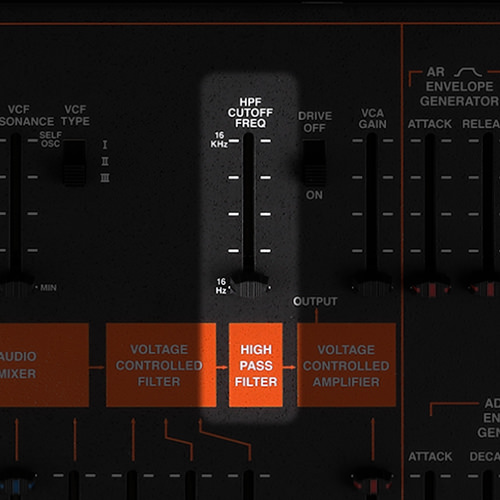
HPF
This is a high-pass filter. If you’re looking for fat sound, you might consider it a pity to reduce the low end, but this is something that is used frequently by synthesizer specialists. While many models place the HPF earlier than the LPF, the ARP Odyssey is also unique in deliberately placing the HPF after the LPF.
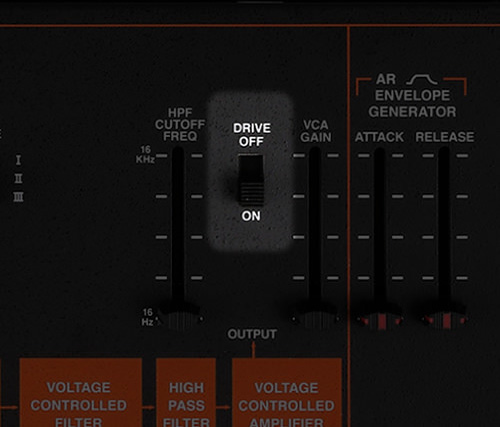
VCA
The DRIVE switch generates distortion in the VCA, and is a parameter that was not found on the original ARP Odyssey. It creates a thick and natural overdrive. This can be used for a wide range of sound design possibilities, and also makes it easier to create modern synthesizer sounds.
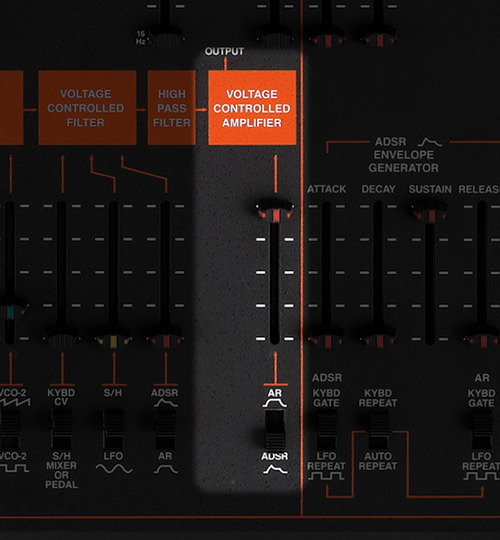
AR / ADSR adjust the sensitivity of the VCA to the envelope generators discussed later, and operate in practice as the master volume of the ARP Odyssey.
Since the VCA is normally controlled by the envelope generator, there are many models that don’t have any parameters for the VCA. That’s why some people confuse the visible envelope generator with the VCA, but they’re entirely separate things. It’s important to understand that the VCA is an audio amp that’s controlled by voltage, and is merely being moved by the envelope generator. The strength of the signal sent from the envelope generator is what determines the output volume of the VCA.
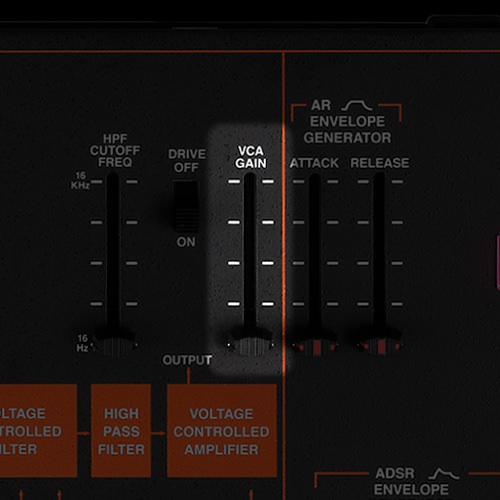
The VCA GAIN slider adjusts the volume of the audio signal that’s sent to the VCA separately from the envelope. In brief, if this slider is raised, the sound won’t stop. This can be used like a Hold switch, so if you want to create a drone sound, or if you’re playing an extended solo part during a live performance and want to let go of the synth and stir up the audience, you might indulge in some coolness by leaving this slider raised to keep the sound going.

 EG
EG